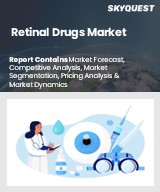
Report ID: SQMIG35I2364
SkyQuest Technology's Retinal drugs market size, share and forecast Report is based on the analysis of market data and Industry trends impacting the global Retinal Drugs Market and the revenue of top companies operating in it. Market Size Data and Statistics are based on the comprehensive research by our Team of Analysts and Industry experts.
Global Retinal Drugs Market size was valued at USD 20.20 Billion in 2023 and is poised to grow from USD 21.86 Billion in 2024 to USD 41.06 Billion by 2032, growing at a CAGR of 8.2% during the forecast period (2025-2032).
The retinal drugs market is Increasingly recognized as the most significant driver, the burden of retinal diseases on an international scale, including age-related macular degeneration (AMD), diabetic retinopathy, and retinal vein occlusion (RVO), has triggered a major shift in the Retinal Medicine market; AMD alone affects more than 196 million people worldwide. The market has seen compounded development as a result of an ageing population, an improved patient base due to diabetes, and increased access to ophthalmic diagnostics and treatment. The supremacy of anti-VEGF drugs, for example, aflibercept (Eylea), ranibizumab (Lucentis), and brolucizumab (Beovu), remains in force and accounts for a major chunk of the revenue generated in the market, the biggest contributor being Eylea, with over $9 billion in sales worldwide. One more thing sustained-release drug delivery systems & gene therapy modalities are redesigning treatment paradigms to cut down on injection frequency, a major compliance inhibitor in chronic conditions. Regenxbio, Roche, and Kodiak Sciences have advanced from their pipeline product these key players are introducing longer-acting, including dual-inhibition therapies, more efficacious molecules, intravitreal implants, and more.
Is the Era of Monthly Eye Injections Finally Ending?
Suppliers are pushing long-acting anti-VEGF treatments hard to minimize the heavy treatment burden of frequent intravitreal injections. Bayer/Regeneron's Eylea HD (8 mg) provides dosing every 12–16 weeks, and Roche's Port Delivery System (Susvimo) provides continuous drug delivery through a refillable implant. Pipeline contenders such as Kodiak Sciences' KSI-301 target biannual injections. These innovations meet high physician and patient need for long-lasting efficacy with less intervention, improved compliance, clinic productivity, and overall treatment experience in chronic retinal diseases.
REQUEST FOR SAMPLE
Global Retinal Drugs Market size was valued at USD 20.20 Billion in 2023 and is poised to grow from USD 21.86 Billion in 2024 to USD 41.06 Billion by 2032, growing at a CAGR of 8.2% during the forecast period (2025-2032).
The competitive landscape of the retinal drug market is marked by intense R&D, strategic acquisitions, and a race toward long-acting and gene-based therapies. Key players like Roche, Regeneron, and Novartis dominate with anti-VEGF therapies, while others like Sandoz and Coherus expand biosimilar portfolios. Merck’s acquisition of EyeBio and Astellas' purchase of Iveric Bio highlight growing M&A activity. Companies are also investing in implants and AI-driven diagnostics to boost adherence and outcomes. The landscape includes branded drugs, biosimilars, gene therapies, delivery innovations, and pipeline diversification—shaping a competitive, innovation-focused market poised for sustained growth. 'Roche Holding AG (incl. Genentech)', 'Regeneron Pharmaceuticals, Inc.', 'Novartis AG', 'Bayer AG', 'Allergan (AbbVie Inc.)', 'Alcon Inc.', 'Santen Pharmaceutical Co., Ltd.', 'MeiraGTx Holdings plc', 'Ocuphire Pharma, Inc.', 'Kodiak Sciences Inc.', 'Adverum Biotechnologies, Inc.', 'Oxurion NV', 'Graybug Vision, Inc.', 'Clearside Biomedical, Inc.', 'Outlook Therapeutics, Inc.', 'Iveric Bio (acquired by Astellas Pharma)', 'Sandoz (a Novartis spin-off for biosimilars)', 'Coherus BioSciences, Inc.', 'Biogen Inc.'
The growth of the retinal drug market is driven by advances in biologics and the growing portfolio of drug delivery systems. Anti-VEGF therapies have improved outcomes while reducing the treatment burden with fewer injections, with Eylea producing over $9.6 billion in 2023. Longer-lasting treatments like Susvimo's long-acting implant and gene therapies like Luxturna were just some examples of technologies that allow sustained treatments. With companies Roche and Novartis advancing clinical trials of several pipeline agents, and AI facilitating early diagnosis, there has never been more progress. All of these innovations of market potential enhance efficacy, lessen treatment burden, and provide access to a larger number of patients, all of which is a formula for growth in the market and delivery personalized treatments.
What Makes North America a Leader in Retinal Drugs?
Want to customize this report? This report can be personalized according to your needs. Our analysts and industry experts will work directly with you to understand your requirements and provide you with customized data in a short amount of time. We offer $1000 worth of FREE customization at the time of purchase.
Feedback From Our Clients

Report ID: SQMIG35I2364
sales@skyquestt.com
USA +1 351-333-4748